Italy
A country that has it all: sea, mountains, sights and great food. But few areas are as impressive as the Dolomites. The Alps are far from being the highest here, nor are they covered in vast glaciers; indeed, the entire Dolomites are criss-crossed with a network of ski slopes and cable cars that can spoil many a photograph. Yet the majesty and colour of the mountains here, together with the relatively stable sunny weather of the southern side of the Alps, attracts photographers from all over the world. And the reasons are certainly justified.
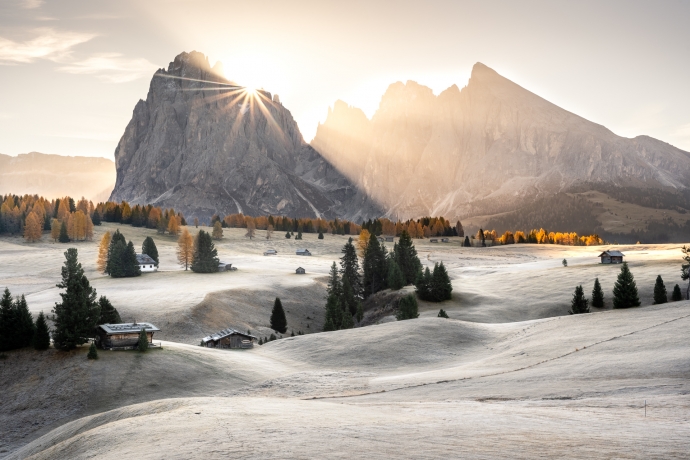
The largest alpine pasture, scattered hayfields all around, the majestic Sassolungo rising like a tower above the flat plains and the sun rising from behind it. Dozens of photographers have occupied the heights above the pastures since early on a frosty morning, waiting for the miracle of light that regularly recurs here. I descend a little lower, not wanting to crowd into a single spot like most others. Tthe plains are large and the possibilities are countless after all. In the end, I am glad for this choice. I may be losing a few haylofts in the foreground, but the grassy waves covered in frost more than make up for them.
Alpe di Siusi
The largest alpine pasture, scattered hayfields all around, the majestic Sassolungo rising like a tower above the flat plains and the sun rising from behind it. Dozens of photographers have occupied the heights above the pastures since early on a frosty morning, waiting for the miracle of light that regularly recurs here. I descend a little lower, not wanting to crowd into a single spot like most others. Tthe plains are large and the possibilities are countless after all. In the end, I am glad for this choice. I may be losing a few haylofts in the foreground, but the grassy waves covered in frost more than make up for them.
- Camera used: SONY ILCE-7C
- Exposure time: 1/500 s
- Aperture: f/13.0
- Focal length: 50mm
- ISO: 100
- Date taken: Oct 27, 2022 07:45:25
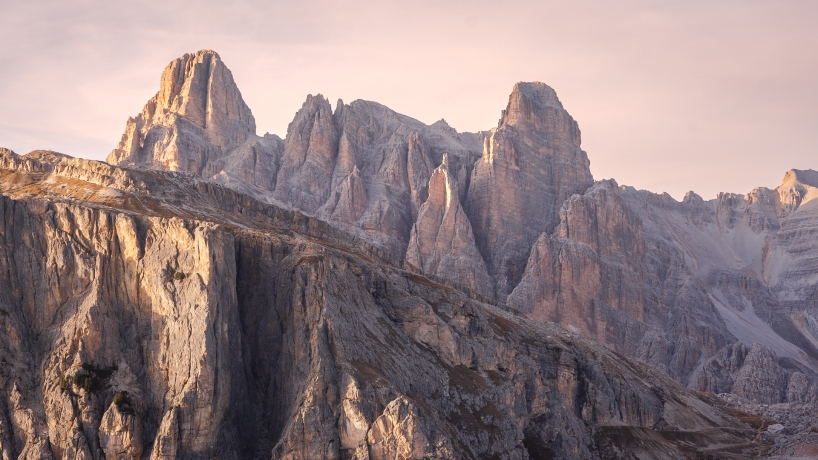
Since early afternoon, my gaze repeatedly turns to the jagged peaks of Punta di Mezzo, Torre Travenanzes and Torre Fanis. I am waiting to see if their peaks will be able to reflect the sun's rays until late evening, when the sun leans towards the horizon and dresses in warm colours. In particular, the detached triangular peak below the main ridge keeps attracting my attention. Only in the evening will it turn out that it, too, remains partially illuminated by the setting sun.
Dolomite peaks
Since early afternoon, my gaze repeatedly turns to the jagged peaks of Punta di Mezzo, Torre Travenanzes and Torre Fanis. I am waiting to see if their peaks will be able to reflect the sun's rays until late evening, when the sun leans towards the horizon and dresses in warm colours. In particular, the detached triangular peak below the main ridge keeps attracting my attention. Only in the evening will it turn out that it, too, remains partially illuminated by the setting sun.
- Camera used: SONY ILCE-7C
- Exposure time: 1/125 s
- Aperture: f/8.0
- Focal length: 90mm
- ISO: 100
- Date taken: Oct 29, 2022 16:01:54
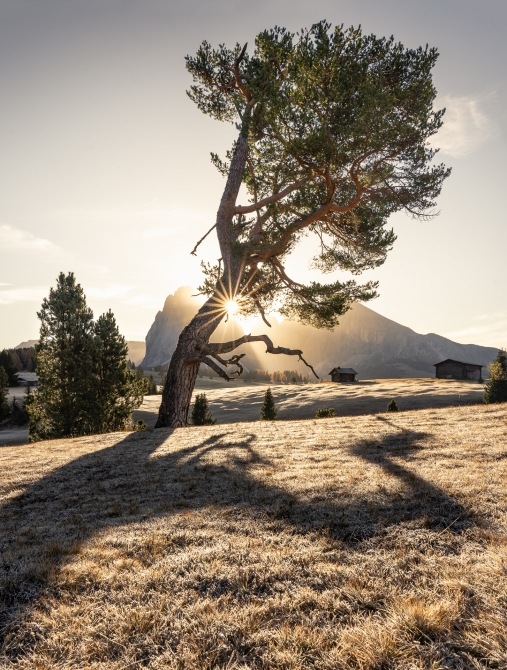
Probably only a fraction of people notice the pine tree growing in the middle of the Alpe di Siusi pasture. But the photographer immediately claps and rushes to the twisted tree. When the conditions are right, the sun rising over Sassolungo stretches the shadow of the pine across the frost-covered meadow.
Shadow of the pine
Probably only a fraction of people notice the pine tree growing in the middle of the Alpe di Siusi pasture. But the photographer immediately claps and rushes to the twisted tree. When the conditions are right, the sun rising over Sassolungo stretches the shadow of the pine across the frost-covered meadow.
- Camera used: SONY ILCE-7C
- Exposure time: 1/125 s
- Aperture: f/13.0
- Focal length: 20mm
- ISO: 100
- Date taken: Oct 27, 2022 07:49:09
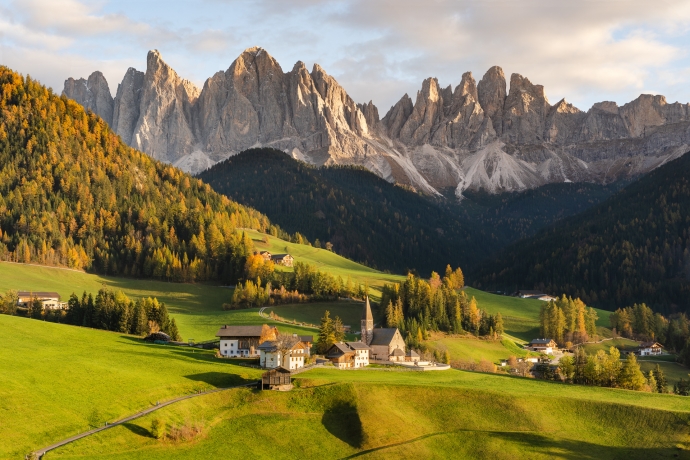
The most beautiful village in the Dolomites, nestled in the Val di Funes valley below the Odle massif. It is for this view that dozens of photographers regularly gather here in the evenings. It is impossible to come up with a revolutionary shot here, the composition is practically a given. The only variable here is the light conditions. But who could resist such a sight?
Santa Maddalena
The most beautiful village in the Dolomites, nestled in the Val di Funes valley below the Odle massif. It is for this view that dozens of photographers regularly gather here in the evenings. It is impossible to come up with a revolutionary shot here, the composition is practically a given. The only variable here is the light conditions. But who could resist such a sight?
- Camera used: SONY ILCE-7C
- Exposure time: 1/30 s
- Aperture: f/9.0
- Focal length: 50mm
- ISO: 100
- Date taken: Oct 26, 2022 16:20:24
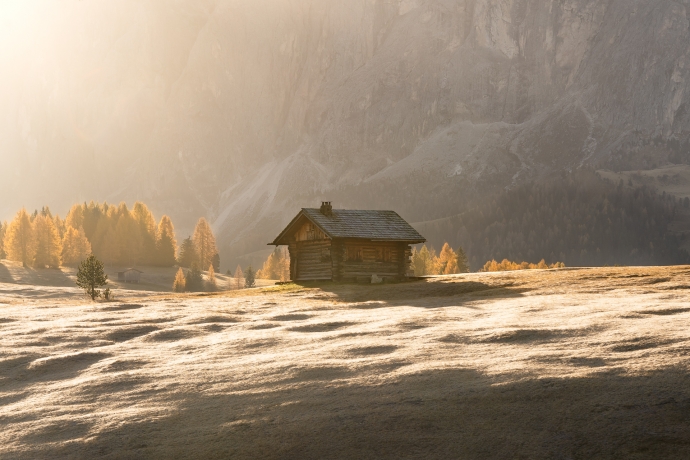
I was afraid that the whole Dolomites were covered with a system of ski slopes and metal masts of lifts and cable cars. And while this is largely true, the situation is far from lost. At the same time, the mountains maintain a traditional pastoral way of life and a vibrant system of haylofts still in use. The wooden buildings scattered across the pastures thus continue to form a rewarding motif.
Hayloft under Sassolungo
I was afraid that the whole Dolomites were covered with a system of ski slopes and metal masts of lifts and cable cars. And while this is largely true, the situation is far from lost. At the same time, the mountains maintain a traditional pastoral way of life and a vibrant system of haylofts still in use. The wooden buildings scattered across the pastures thus continue to form a rewarding motif.
- Camera used: SONY ILCE-7C
- Exposure time: 1/250 s
- Aperture: f/8.0
- Focal length: 90mm
- ISO: 100
- Date taken: Oct 27, 2022 07:51:05
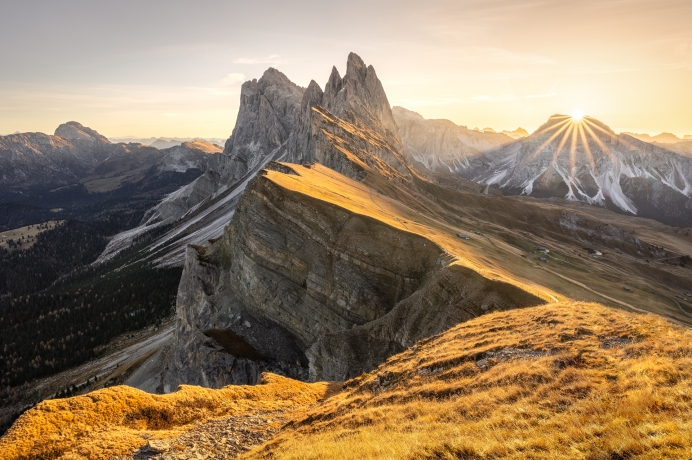
The edge of the Dolomites, the gently grassy plains suddenly and unexpectedly break and fall down with a perpendicular rock wall into the Funes valley. With autumn, the green of the grass recedes and the disc of the rising sun moves more to the right of the main group of peaks. Even so, the sun conjures up an unforgettable spectacle on terrain breaks and emphasizes diagonals.
Seceda
The edge of the Dolomites, the gently grassy plains suddenly and unexpectedly break and fall down with a perpendicular rock wall into the Funes valley. With autumn, the green of the grass recedes and the disc of the rising sun moves more to the right of the main group of peaks. Even so, the sun conjures up an unforgettable spectacle on terrain breaks and emphasizes diagonals.
- Camera used: SONY ILCE-7C
- Exposure time: 1/800 s
- Aperture: f/11.0
- Focal length: 20mm
- ISO: 100
- Date taken: Oct 28, 2022 07:10:13
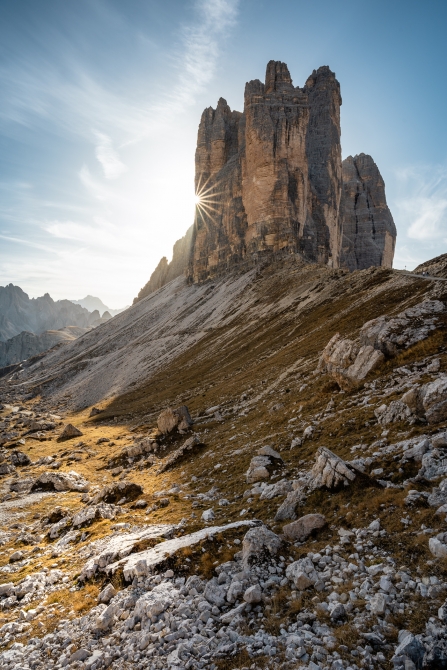
The sun isn't quite low yet, but the towers of Tre Cime tower damn high. They cast a long shadow, already visible from the distance. Just get closer to the edge of the light, and it's an interesting game. In a few seconds, the sun's disc disappears and you have to move a few metres again. A few seconds and the shadow is back. It goes on and on. An interesting variation on trying to photograph mountains with a rising star of sunlight.
On the edge of light
The sun isn't quite low yet, but the towers of Tre Cime tower damn high. They cast a long shadow, already visible from the distance. Just get closer to the edge of the light, and it's an interesting game. In a few seconds, the sun's disc disappears and you have to move a few metres again. A few seconds and the shadow is back. It goes on and on. An interesting variation on trying to photograph mountains with a rising star of sunlight.
- Camera used: SONY ILCE-7C
- Exposure time: 1/100 s
- Aperture: f/11.0
- Focal length: 20mm
- ISO: 100
- Date taken: Oct 28, 2022 14:53:44
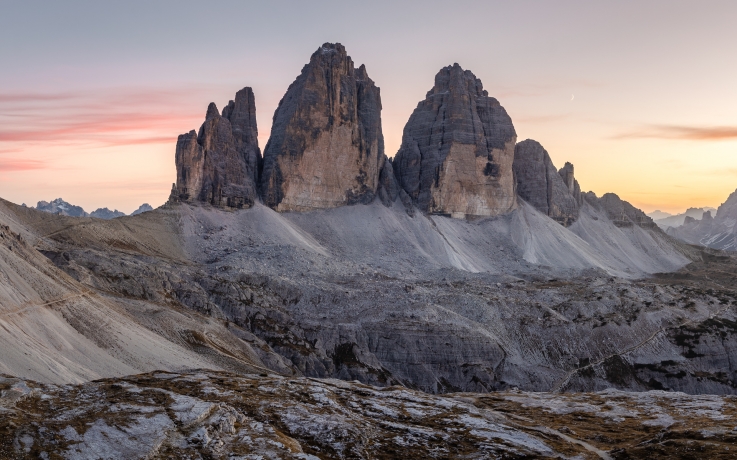
A Dolomite classic above all others, there is no more famous peak in these mountains. And the number of visitors unfortunately corresponds to this. Only in the evening does the situation calm down and the rocky wasteland regains its natural face - quiet and majestic. When the bands of reds appear behind the Tre Cime and the crescent moon lights up to the right of the trio of peaks, I know it's time to start taking pictures.
Moon over Tre Cime
A Dolomite classic above all others, there is no more famous peak in these mountains. And the number of visitors unfortunately corresponds to this. Only in the evening does the situation calm down and the rocky wasteland regains its natural face - quiet and majestic. When the bands of reds appear behind the Tre Cime and the crescent moon lights up to the right of the trio of peaks, I know it's time to start taking pictures.
- Camera used: SONY ILCE-7C
- Exposure time: 1/10 s
- Aperture: f/8.0
- Focal length: 35mm
- ISO: 100
- Date taken: Oct 28, 2022 17:04:06
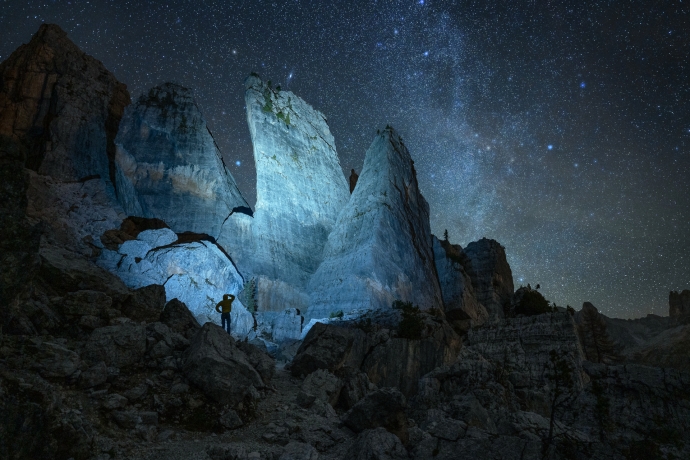
As soon as I see the Cinque Torri rock formation, I know I have to try to take a night photo here. I originally planned to take a shot facing east, but it's not quite right. Taking into account the weather forecast and using a photo app, I estimate the position of the Milky Way during the night and finally choose a view facing west around 2am - by then even the remnants of the evening clouds should be gone. The composition is fine, but the dark rocks don't stand out much on their own. So I enter the scene to face the rock giants. I turn on my headlamp, just for a few seconds, and the rock giants come to life.
Facing the giants
As soon as I see the Cinque Torri rock formation, I know I have to try to take a night photo here. I originally planned to take a shot facing east, but it's not quite right. Taking into account the weather forecast and using a photo app, I estimate the position of the Milky Way during the night and finally choose a view facing west around 2am - by then even the remnants of the evening clouds should be gone. The composition is fine, but the dark rocks don't stand out much on their own. So I enter the scene to face the rock giants. I turn on my headlamp, just for a few seconds, and the rock giants come to life.
- Camera used: SONY ILCE-7C
- Exposure time: 13/1 s
- Aperture: f/2.0
- Focal length: 20mm
- ISO: 1600
- Date taken: Oct 30, 2022 02:51:34
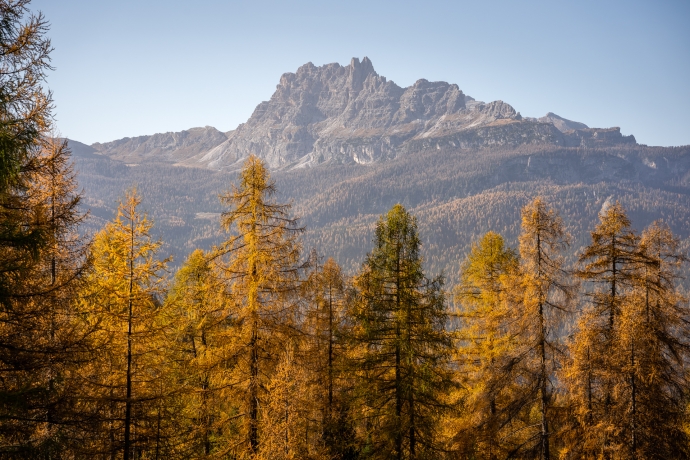
What an autumn in the Dolomites it would be if the golden crowns of the local larches were missing. It is the larch trees together with the massive orange-coloured rock massifs that characterise this unique area. However, arrive just a few days late and the golden crowns will remain only in the deep valleys protected from wind and cold.
Autumn in the Dolomites
What an autumn in the Dolomites it would be if the golden crowns of the local larches were missing. It is the larch trees together with the massive orange-coloured rock massifs that characterise this unique area. However, arrive just a few days late and the golden crowns will remain only in the deep valleys protected from wind and cold.
- Camera used: SONY ILCE-7C
- Exposure time: 1/400 s
- Aperture: f/8.0
- Focal length: 90mm
- ISO: 100
- Date taken: Oct 29, 2022 09:44:52
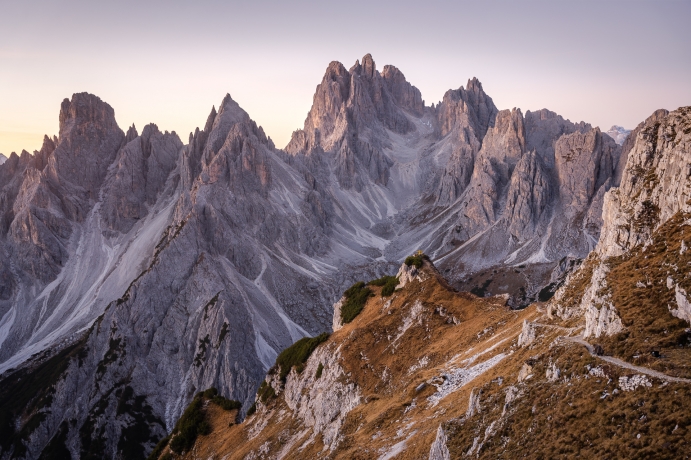
A place that has been getting a lot of attention lately. A winding path leads to an exposed viewpoint with the sharp peaks of the Cadini group towering above. For me, one of the biggest positive surprises of the Dolomites in the form of some of the most impressive mountain scenery I have had the opportunity to see.
Cadini di Misurina
A place that has been getting a lot of attention lately. A winding path leads to an exposed viewpoint with the sharp peaks of the Cadini group towering above. For me, one of the biggest positive surprises of the Dolomites in the form of some of the most impressive mountain scenery I have had the opportunity to see.
- Camera used: SONY ILCE-7C
- Exposure time: 4/10 s
- Aperture: f/8.0
- Focal length: 35mm
- ISO: 100
- Date taken: Oct 29, 2022 06:27:00
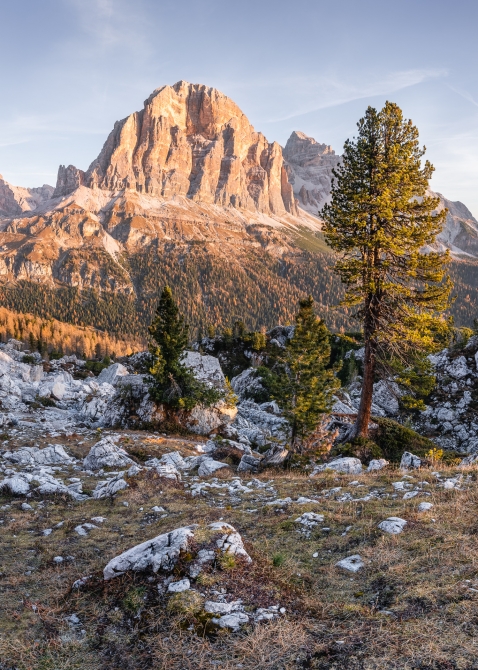
Waiting for the first rays of the new day under Tofana di Rozes. The sun gradually leans into the very top, climbs down the rock face and finally illuminates the forest in the valley. But the crowns of the nearby pines are still too dark, so I wait longer for the sun's disc to climb even higher. Eventually the rays reach the pines too. I frame this picture vertically, better separating the massive Tofana from the surrounding peaks.
Tofana di Rozes
Waiting for the first rays of the new day under Tofana di Rozes. The sun gradually leans into the very top, climbs down the rock face and finally illuminates the forest in the valley. But the crowns of the nearby pines are still too dark, so I wait longer for the sun's disc to climb even higher. Eventually the rays reach the pines too. I frame this picture vertically, better separating the massive Tofana from the surrounding peaks.
- Camera used: SONY ILCE-7C
- Exposure time: 1/80 s
- Aperture: f/10.0
- Focal length: 20mm
- ISO: 100
- Date taken: Oct 30, 2022 07:09:36
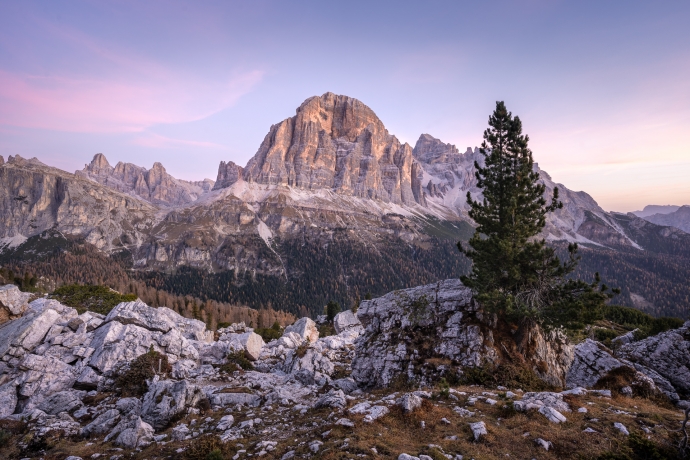
The mighty south face of Tofana di Rozes attracts attention from far and wide. In the evening I am already thinking about the composition for the morning - and there are not many options. Most of the surrounding area is either bare grassy plains or broken stone fields. In either case, it comes out rather empty photographically. The larch trees in the valley have mostly lost their colourful needles. The only chance is the lone pines growing higher up, which will complete the composition and add context to the massiveness of the stone mountains.
Tofana at dawn
The mighty south face of Tofana di Rozes attracts attention from far and wide. In the evening I am already thinking about the composition for the morning - and there are not many options. Most of the surrounding area is either bare grassy plains or broken stone fields. In either case, it comes out rather empty photographically. The larch trees in the valley have mostly lost their colourful needles. The only chance is the lone pines growing higher up, which will complete the composition and add context to the massiveness of the stone mountains.
- Camera used: SONY ILCE-7C
- Exposure time: 1/3 s
- Aperture: f/10.0
- Focal length: 20mm
- ISO: 100
- Date taken: Oct 30, 2022 06:33:08
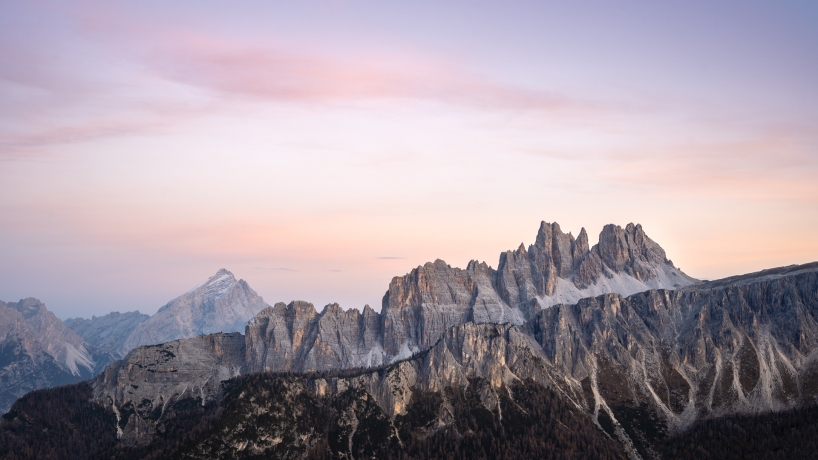
All evening I watch the magically pointed ridge of the Croda da Lago group. It would have been nice if the peaks were illuminated by the last rays of the evening sun, but the time of year is not favourable and a part of the valley is covered by a sharp shadow of several mountains located more to the west. Only after dusk, when the first reds appear, does the massif stand out as I would have imagined.
Croda da Lago
All evening I watch the magically pointed ridge of the Croda da Lago group. It would have been nice if the peaks were illuminated by the last rays of the evening sun, but the time of year is not favourable and a part of the valley is covered by a sharp shadow of several mountains located more to the west. Only after dusk, when the first reds appear, does the massif stand out as I would have imagined.
- Camera used: SONY ILCE-7C
- Exposure time: 1/8 s
- Aperture: f/8.0
- Focal length: 50mm
- ISO: 100
- Date taken: Oct 29, 2022 16:56:27
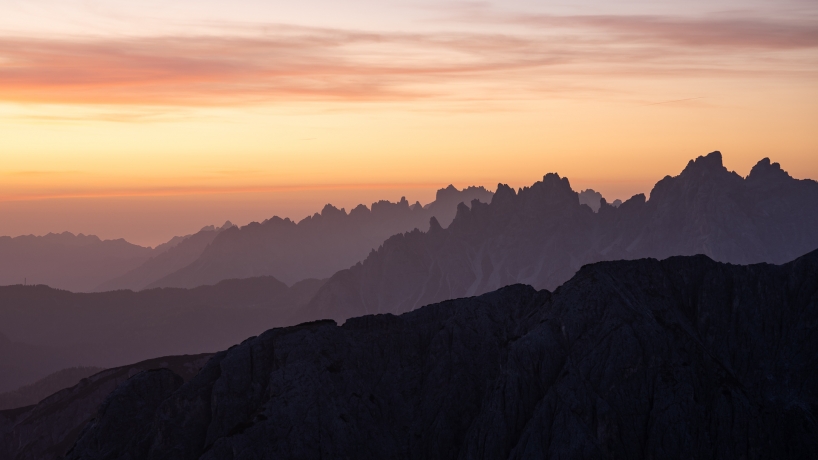
In the early morning, at the moment when it is possible to move without a headlamp, but the sky is still dark and the stars are still visible, a strip of the eastern horizon lights up in the wildest colours. The sharp points of distant ridges are just timidly vying for the attention of the upcoming day. One ridge after another fades smoothly into the distance.
Disappearing peaks
In the early morning, at the moment when it is possible to move without a headlamp, but the sky is still dark and the stars are still visible, a strip of the eastern horizon lights up in the wildest colours. The sharp points of distant ridges are just timidly vying for the attention of the upcoming day. One ridge after another fades smoothly into the distance.
- Camera used: SONY ILCE-7C
- Exposure time: 1/3 s
- Aperture: f/5.6
- Focal length: 90mm
- ISO: 100
- Date taken: Oct 29, 2022 06:16:39
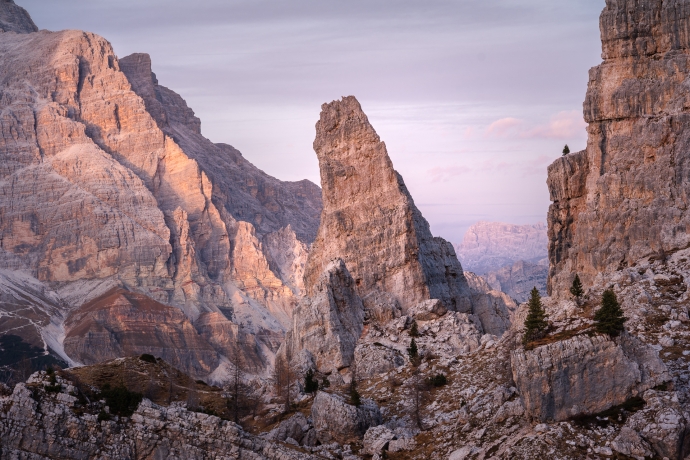
A view through the side towers of the Cinque Torri to the western face of Punta Anna lit by last evening light. Just before sunset, when the sunlight softens the shadows, even the finest details in the dolomite rock become visible. This is when the mountains are at their most stunning.
Dolomite views
A view through the side towers of the Cinque Torri to the western face of Punta Anna lit by last evening light. Just before sunset, when the sunlight softens the shadows, even the finest details in the dolomite rock become visible. This is when the mountains are at their most stunning.
- Camera used: SONY ILCE-7C
- Exposure time: 1/25 s
- Aperture: f/8.0
- Focal length: 90mm
- ISO: 100
- Date taken: Oct 29, 2022 16:44:11
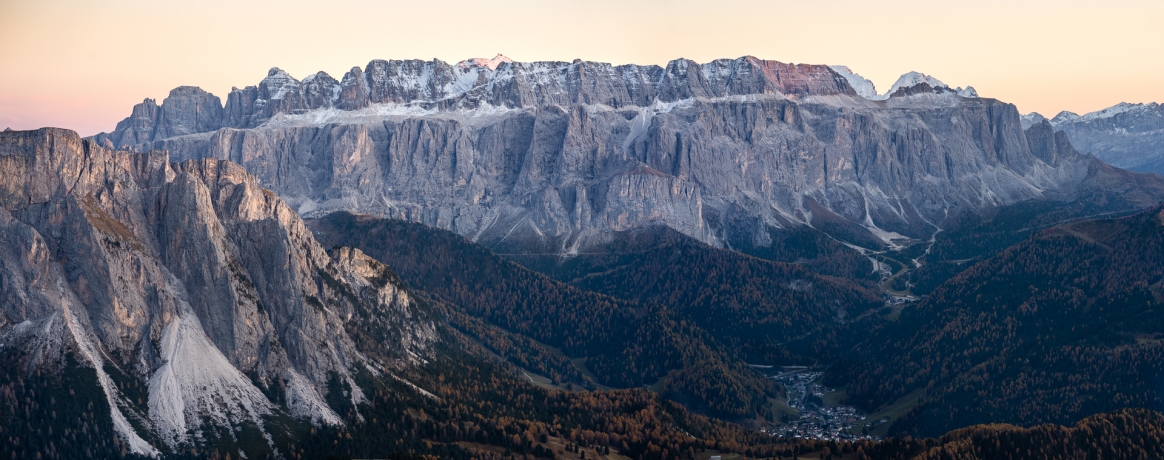
Together with Sassolungo, Sella is one of the symbols of the Dolomites for me. It is not pointed, it does not attract as much immediate attention as other peaks. It is a flat mass of rock with dimensions that are hard to imagine. The whole area arounds is easily accessible through mountain passes, but the mountain itself still feels out of reach. In the evening colours even the subtle transitions on the vertical edges and ribs show through.
Gruppo del Sella
Together with Sassolungo, Sella is one of the symbols of the Dolomites for me. It is not pointed, it does not attract as much immediate attention as other peaks. It is a flat mass of rock with dimensions that are hard to imagine. The whole area arounds is easily accessible through mountain passes, but the mountain itself still feels out of reach. In the evening colours even the subtle transitions on the vertical edges and ribs show through.
- Camera used: SONY ILCE-7C
- Exposure time: 1/8 s
- Aperture: f/8.0
- Focal length: 90mm
- ISO: 100
- Date taken: Oct 27, 2022 16:58:58